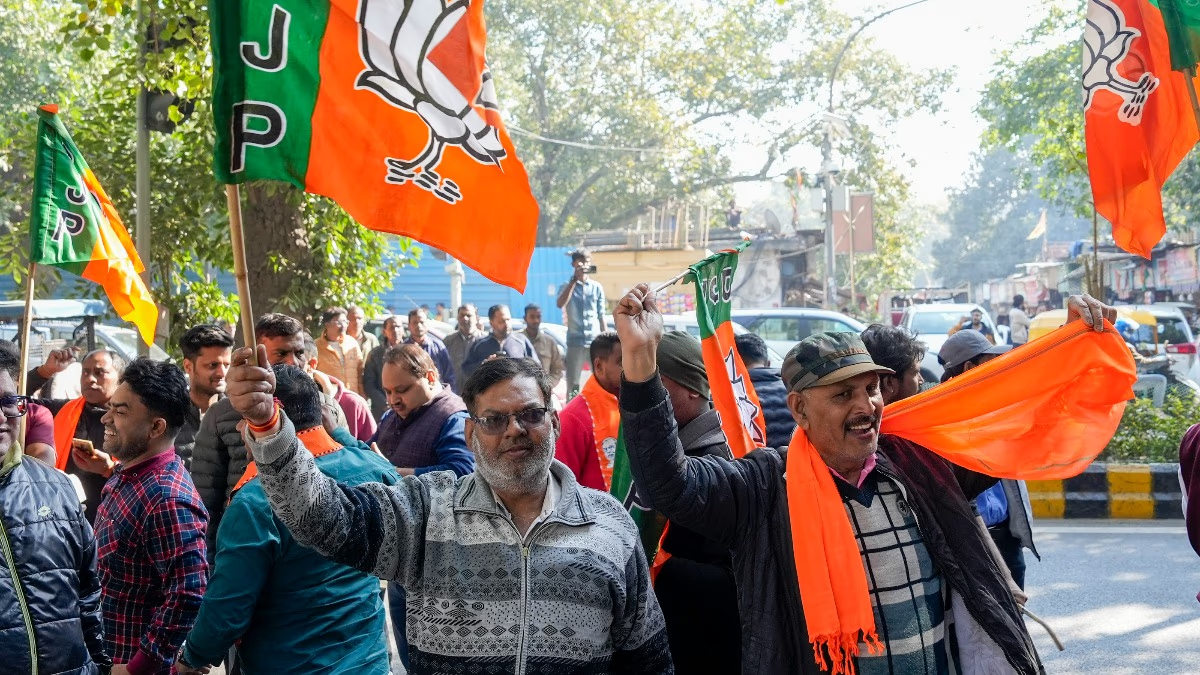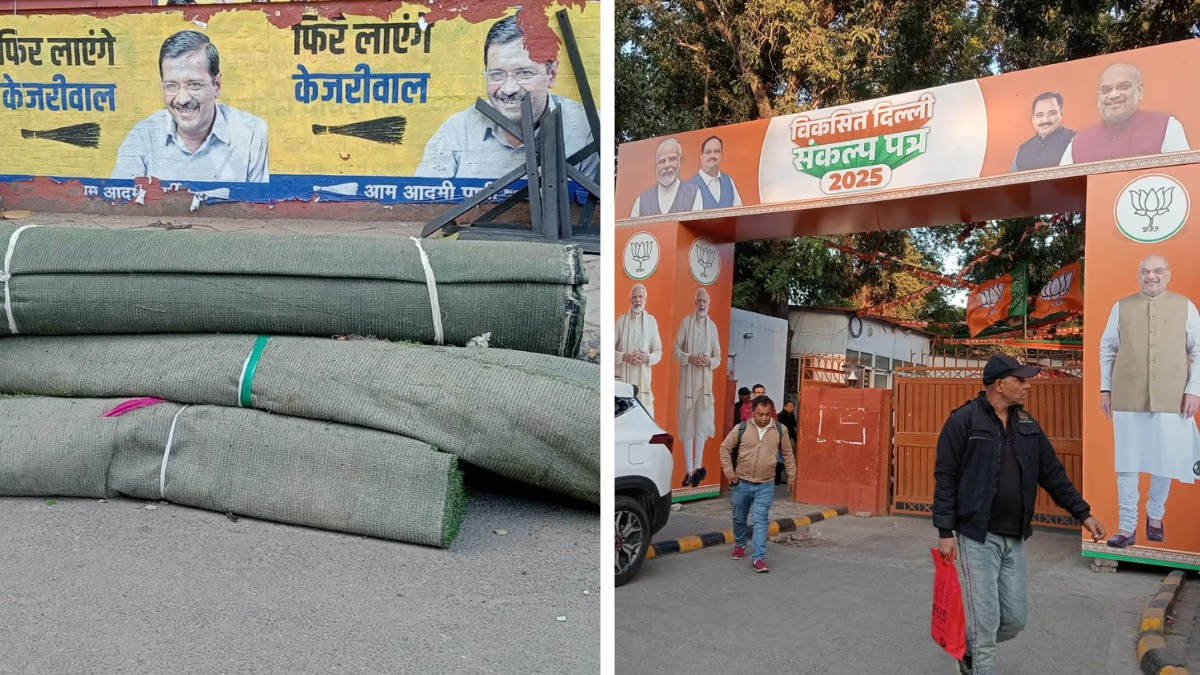After a 27-year-long hiatus, the BJP seems to be storming back into power in Delhi. The latest assembly election results indicate that the Bharatiya Janata Party is set to win more than 45 of the 70 seats in the Delhi Assembly. The magic number required to form a government in Delhi is 36.
Since 2014, the BJP has achieved remarkable electoral successes across India. It is in power at the center for the third time, having expanded its influence nationwide. Yet, despite its grand headquarters in Delhi, the BJP has been yearning for power in the national capital since 1998.
From 1998 to 2025, a gap of 27 years. But now, the political mood in Delhi along the Yamuna has shifted. The BJP has made a strong comeback in Delhi. But what is the X factor in this comeback? How did the BJP manage to break the magic of Kejriwal's free water, electricity, and bus services? Let's understand in 7 points.
In the Delhi election, the BJP tackled the Aam Aadmi Party on their strongest electoral plank. Free electricity and water were Kejriwal's two main issues that redefined elections in India.
The BJP nurtured this issue and moved ahead of Kejriwal. In the Delhi elections, BJP went further than Kejriwal in its promises of freebies.
The BJP announced a financial aid of ₹2,500 per month for women, surpassing Kejriwal's offer of ₹2,100. Along with this, the BJP announced several initiatives like providing LPG cylinders at ₹500, one free cylinder each on Holi and Diwali, nutrition kits for pregnant women, nutritious meals for slum dwellers at ₹5, and free healthcare for senior citizens over 70 years of age. The pension for senior citizens was promised to increase from 2,000 to 2,500. Additionally, the BJP promised free medical treatment up to 10 lakhs for the people of Delhi.
Meanwhile, the Aam Aadmi Party was already running schemes offering free electricity, water, healthcare, education, free bus rides for women, and pilgrimage tours for senior citizens in Delhi. Kejriwal had vowed to expand these further, promising full medical coverage for seniors, monthly allowances for priests and temple workers, and free bus travels for students. AAP also promised a 50% concession for students in the Delhi Metro.
However, the public favored BJP's announcements more.
During the campaign, AAP suggested that free electricity and water schemes would end if the BJP gained power. To dispel this notion, the BJP brought PM Modi into the fray. In his rallies, PM Modi assured that no free scheme would cease, rather they would be augmented. The BJP adapted a similar strategy and countered phone rumors that the free schemes would end if BJP came to power.
For the past 11 years, Kejriwal portrayed himself as staunchly honest. During the election, the issue of government spending on renovating former CM Arvind Kejriwal's residence gained traction. The BJP labeled this as Kejriwal's 'Glass Palace' built on taxpayer money.
By raising this issue in speeches and Parliament, PM Modi broke Kejriwal's honest image. He conveyed that even the Aam Aadmi Party, which came to power claiming simplicity and honesty, was no different than other parties, concerned more with personal luxuries.
The BJP turned 'Glass Palace' into a major electoral issue, targeting Kejriwal's image as an 'Aam Aadmi.' It was presented as a symbol of corruption and misuse of public funds, mainly for those who believed in Kejriwal's simplicity.
Just a day before the Delhi elections, PM Modi stated in Parliament that funds saved by his government were used for national development, not for personal luxury. In rallies, he proclaimed that he could have built grand residences but chose to aim for robust housing for the poor.
The pollution of the Yamuna, crucial to Delhi's lifeline, stirred significant uproar during the elections. Kejriwal had repeatedly promised to clean the Yamuna, claiming it would be fit for bathing. However, he failed to deliver on this promise.
This issue saw intense blame games during the elections.
Amid voter awareness campaigns, Yamuna's cleanliness became a central theme. Local groups, NGOs, and environmental activists heightened public consciousness around this issue, making it a focal point of electoral debates.
Toward the election's end, Kejriwal held the BJP junta in Haryana responsible for the Yamuna's pollution, claiming deliberate contamination. He accused the Haryana government of willfully polluting the Yamuna.
CM Atishi even alleged that fearing election loss, the BJP wanted to deprive Delhiites of water by releasing toxic water into the Yamuna.
But the public rejected AAP's narrative. Meanwhile, the BJP promised that if BJP governs both the Delhi and Haryana, they would clean the Yamuna at a mission level. Now the challenge before BJP, is to succeed in this mission.
The Aam Aadmi Party provided free water in Delhi. But was this free water fit for consumption? The BJP capitalized on this issue during the Delhi election. BJP workers posted pictures of sewage-mixed water supply on social media and questioned AAP leaders about it.
Kejriwal couldn't effectively respond to Delhiites' anger over this dirty water. Instead, he accused the BJP's Haryana government, inflaming election tensions further.
On January 27, Kejriwal said at a rally, 'Depriving people of water is a grave sin. The BJP, with its dirty politics, wants to leave Delhiites thirsty. They are contaminating water sent from Haryana.'
Further, he added, 'This polluted water is so toxic that it can't be treated using existing water treatment plants in Delhi. The BJP aims to harm Delhiites, but we won't allow it.'
These severe allegations did not sit well with the electorate, who showed their discontent in the election results. Kejriwal had 11 years to supply clean water, yet it remained unattainable for Delhiites.
In this election, the BJP gave no breathing space to the top leaders of the Aam Aadmi Party, fielding its stalwart leaders against them. The BJP fielded Parvesh Verma against former CM Arvind Kejriwal and gave Ramesh Bidhuri a ticket against CM Atishi. The BJP exploited these leaders' popularity and political experience against AAP.
Due to BJP's effective strategies, Manish Sisodia had to switch his seat.
This focus on AAP's key leaders meant they had to prioritize their own constituencies, limiting their reach in other constituencies to micro-manage effectively.
This was a strategic arrow in BJP's electoral quiver, which it successfully wielded in several elections. Considering factionalism, caste alliances, and regional identity issues, the BJP refrained from announcing a chief ministerial candidate in recent elections, including Delhi.
This strategy resulted in a unified vote from BJP's supporters, be they Purvanchali, Pahari, or Punjabi. The vote wasn't divided, and debates around meritless candidates like 'Savarna', 'Dalit', 'OBC', and 'Baniya' were avoided. The focus remained on dismantling the Aam Aadmi Party's narrative, and in this, BJP succeeded.
The BJP utilized this formula successfully in Haryana, Chhattisgarh, Rajasthan, Madhya Pradesh, and Maharashtra elections.
Seats like Seelampur, Mustafabad, Matia Mahal, Ballimaran, Okhla, Babarpur, Gandhinagar, Seemapuri, Chandni Chowk, Sadar Bazar, Kirari, and Jangpura have a decisive number of Muslim voters. These seats had Congress, AAP, and even AIMIM candidates in Mustafabad and Okhla.
The results indicated that the equations on these seats benefitted the BJP.
Take Mustafabad for example. BJP's Mohan Singh Bisht took a significant lead of 43,000 votes here. The Aam Aadmi Party stood second, and Tahir Hussain, an accused in the Delhi riots, was third.
Talking about Jangpura, it too is a Muslim-majority seat. The BJP defeated Manish Sisodia on this seat. Sisodia lost by just a few hundred votes, while the Congress candidate Farhad Suri, in third place, received 7,000 votes.
Rise of AAP
Recall that in 2013, during Delhi's assembly elections, the BJP had great expectations but stalled at 31 seats. The 2015 electoral battlefield was a thrilling mix of drama and challenge. By 2014, Narendra Modi had delivered a miracle election, seizing the central power with a full majority.
In Delhi, Arvind Kejriwal's popularity soared in 2015. The encounter between Modi's rising allure and Kejriwal's charisma led to an electrifying contest where Kejriwal outshone, winning 67 out of 70 seats. The mammoth arrival of AAP had sounded its horn, leaving BJP awe-struck.
Despite Modi's charisma repeating in the 2019 central election, Delhi too seemed to echo back a 'story-repeat' in 2020, where again AAP grabbed 62 seats, silencing critics and cornering BJP and Congress.
Yet, 11 years later, AAP's pride has dimmed and faded away.




